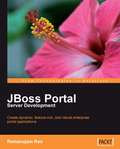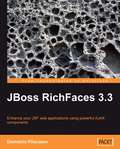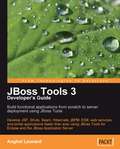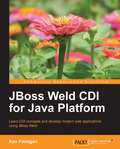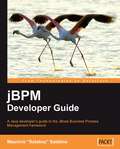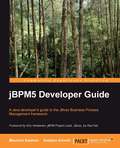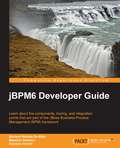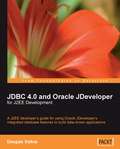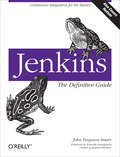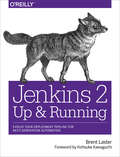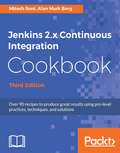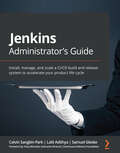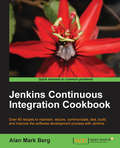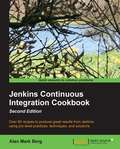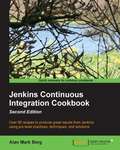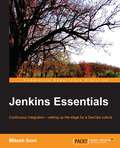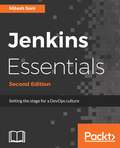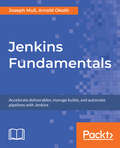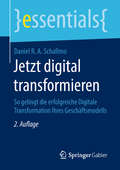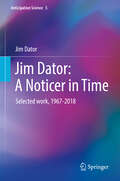- Table View
- List View
JBoss Portal Server Development
by Ramanujam RaoThe book is written from a developer perspective and uses an example-driven approach with extensive code samples on each topic, for easy understanding and learning. It starts with some basic concepts of portals, before going into the features and implementation of JBoss Portal and eventually discussing some concepts for advanced use. Each chapter provides a blend of just enough basic concepts to start building applications and detailed configurations for reference. This book is for portal developers, portal administrators, designers and architects working on the Java platform, who want to build web portal solutions. The book doesn't expect an expert knowledge of portal or JEE technologies, but does presume a basic understanding of web technologies and the Java/JEE platform. However, the concepts are lucid enough that any competent developer can easily find immediate value in the book and start creating dynamic portal applications.
JBoss RichFaces 3.3
by Demetrio FilocamoThis is a practical tutorial following the use of RichFaces in a sample application. It includes many examples of the creation and customization of different AJAX components. This book targets Java Developers who want to enhance their JSF applications by adding AJAX, but without having to use JavaScript. If you want to learn how to use the wide set of AJAX components that you find in the RichFaces framework, this book is for you. You are expected to have basic knowledge of JSF, but no previous experience with AJAX is necessary.
JBoss Tools 3 Developers Guide
by Anghel LeonardSince these technologies covered are different from each other, they are covered in separate chapters that are not interdependent; therefore you can learn to use whichever tool you want, without exploring the previous chapters. This approach sustains the learning per example paradigm and helps you to use the book as a quick guide for your favorite technologies. This book is recommended for Java developers who use at least one of the covered technologies (JSF, Struts, Hibernate, Seam, and so on). It is for all Java developers who are looking for a powerful, unitary tool, especially designed to increase the speed of development and quality of Java web applications. No matter how much (or how little) experience they have, developers of all levels will benefit as their use of JBoss Tools is directly proportional to the complexity of their application. Since JBoss Tools covers all levels of experience, you can use it at your own level for your own applications, without involving unnecessary features. All you need is to be familiar with the Eclipse environment and Java core, and to have some expertise in the technology for which you want to use the JBoss Tools. Basic expertise for each technology is provided in the book, but for more complete and detailed aspects you should read dedicated specifications, tutorials, and articles.
JBoss Weld CDI for Java Platform
by Ken FinneganThis book is a mini tutorial with plenty of code examples and strategies to give you numerous options when building your own applications."JBoss Weld CDI for Java Platform" is written for developers who are new to dependency injection. A rudimentary knowledge of Java is required.
jBPM Developer Guide
by Mauricio SalatinoThis book is a complete developer's guide to working with jBPM in a J2EE enterprise environment. It is packed with examples of implementations that will provide you with all the experience needed in real-life implementations. Extensive discussions about how the framework is implemented internally will contribute to creating a robust knowledge of when and how your projects will include this framework. This book is mainly targeted at Java developers and Java architects who need to have a deep understanding of how frameworks behave in real-life implementations. The book assumes that you know the Java Language well and also know some widely used frameworks such as Hibernate and Log4J. You should also know the basics of relational databases and the Eclipse IDE. A brief introduction to Maven2 is included in this book but extra experience might be needed for more advanced usages.
jBPM Developer Guide
by Mauricio SalatinoThis book is a complete developer's guide to working with jBPM in a J2EE enterprise environment. It is packed with examples of implementations that will provide you with all the experience needed in real-life implementations. Extensive discussions about how the framework is implemented internally will contribute to creating a robust knowledge of when and how your projects will include this framework. This book is mainly targeted at Java developers and Java architects who need to have a deep understanding of how frameworks behave in real-life implementations. The book assumes that you know the Java Language well and also know some widely used frameworks such as Hibernate and Log4J. You should also know the basics of relational databases and the Eclipse IDE. A brief introduction to Maven2 is included in this book but extra experience might be needed for more advanced usages.
jBPM6 Developer Guide
by Mariano Nicolas Maio Esteban Aliverti Mauricio SalatinoIf you are a Java developer or architect who needs to have a better understanding of how Business Process Management frameworks behave in real-life implementations, this book is for you. This book assumes that you know the Java language well and are familiar with some widely used frameworks such as Hibernate. You should also know the basics of relational databases and Maven-based applications.
JDBC 4.0 and Oracle JDeveloper for J2EE Development
by Deepak VohraBeing a quick reference guide, this book has a focused approach. You will learn to develop J2EE applications with JDBC and JDeveloper in no time. The book covers lot of practical examples, which makes it developer-friendly learning material. The book is suitable for Java/J2EE and Oracle JDeveloper beginners. If you are a J2EE developer and want to use the JDeveloper IDE for J2EE development, this book is for you. JDeveloper developers who are new to J2EE will also benefit from the book. Most J2EE applications have a database component and the book is specially suited for database-based J2EE development in Oracle JDeveloper. You can also use this book if you are interested in learning how to utilize the new features offered in JDBC 4.0 for Java/J2EE development.
Jeff Bezos
by Chris McNabO HOMEM QUE REVOLUCIONOU O MUNDO DOS NEGÓCIOS Fundador e CEO da Amazon até 2021, Jeff Bezos é amplamente considerado um dos empresários mais bem-sucedidos do mundo, aparecendo nos lugares cimeiros do índice de riqueza da Forbes.Este livro debruça-se sobre as suas primeiras influências, a sua educação, as decisões que tomou na sua impressionante carreira e o modo como construiu e gere o seu império de negócios, que teve início numa startup fundada na sua própria garagem. Atualmente, Jeff Bezos mantém-se como o principal acionista da Amazon, mas os seus interesses viram-se agora para áreas como a filantropia, a educação da geração mais jovem e a exploração do espaço, tendo fundado a empresa de astronáutica Blue Origin e realizado em 2021 a sua primeira expedição ao espaço.
Jeff Smith's Senior Portrait Photography Handbook
by Jeff SmithWith detailed, informative instructions for capturing personable and memorable yearbook photos, this reference presents step-by-step demonstrations on advertising, talking to clients, producing outstanding images, and finalizing a sale. Noting the delicate balance of pleasing parents and teens alike, this resource illustrates how to marry the latest fashion-oriented photography trends with the needs of the family member who is paying for the session. A wealth of lighting and posing techniques combine with tips for analyzing the subject, choosing which features to accent and which to downplay, and creating alluring, fashionable looks that the whole family can appreciate. Emphasizing the value in allowing seniors to personalize their photos by bringing the shoot to their home or a more meaningful location, the guide also includes suggestions for incorporating additional visual elements such as pets, musical instruments, team uniforms, best friends, or significant others.
Jenkins: Continuous Integration for the Masses (Oreilly And Associate Ser.)
by John Ferguson SmartStreamline software development with Jenkins, the popular Java-based open source tool that has revolutionized the way teams think about Continuous Integration (CI). This complete guide shows you how to automate your build, integration, release, and deployment processes with Jenkins--and demonstrates how CI can save you time, money, and many headaches. Ideal for developers, software architects, and project managers, Jenkins: The Definitive Guide is both a CI tutorial and a comprehensive Jenkins reference. Through its wealth of best practices and real-world tips, you'll discover how easy it is to set up a CI service with Jenkins. Learn how to install, configure, and secure your Jenkins server Organize and monitor general-purpose build jobs Integrate automated tests to verify builds, and set up code quality reporting Establish effective team notification strategies and techniques Configure build pipelines, parameterized jobs, matrix builds, and other advanced jobs Manage a farm of Jenkins servers to run distributed builds Implement automated deployment and continuous delivery
Jenkins 2: Evolve Your Deployment Pipeline for Next Generation Automation
by Brent LasterDesign, implement, and execute continuous delivery pipelines with a level of flexibility, control, and ease of maintenance that was not possible with Jenkins before. With this practical book, build administrators, developers, testers, and other professionals will learn how the features in Jenkins 2 let you define pipelines as code, leverage integration with other key technologies, and create automated, reliable pipelines to simplify and accelerate your DevOps environments.Author Brent Laster shows you how Jenkins 2 is significantly different from the more traditional, web-only versions of this popular open source automation platform. If you’re familiar with Jenkins and want to take advantage of the new technologies to transform your legacy pipelines or build new modern, automated continuous delivery environments, this is your book.Create continuous delivery pipelines as code with the Jenkins domain-specific languageGet practical guidance on how to migrate existing jobs and pipelinesHarness best practices and new methods for controlling access and securityExplore the structure, implementation, and use of shared pipeline librariesLearn the differences between declarative syntax and scripted syntaxLeverage new and existing project types in JenkinsUnderstand and use the new Blue Ocean graphical interfaceTake advantage of the capabilities of the underlying OS in your pipelineIntegrate analysis tools, artifact management, and containers
Jenkins 2.x Continuous Integration Cookbook - Third Edition
by Alan Mark Berg Mitesh SoniGet a problem-solution approach enriched with code examples for practical and easy comprehension About This Book • Explore the use of more than 40 best-of-breed plug-ins for improving efficiency • Secure and maintain Jenkins 2.x by integrating it with LDAP and CAS, which is a Single Sign-on solution • Efficiently build advanced pipelines with pipeline as code, thus increasing your team's productivity Who This Book Is For If you are a Java developer, a software architect, a technical project manager, a build manager, or a development or QA engineer, then this book is ideal for you. A basic understanding of the software development life cycle and Java development is needed, as well as a rudimentary understanding of Jenkins. What You Will Learn • Install and Configure Jenkins 2.x on AWS and Azure • Explore effective ways to manage and monitor Jenkins 2.x • Secure Jenkins 2.x using Matrix-based Security • Deploying a WAR file from Jenkins 2.x to Azure App Services and AWS Beanstalk • Automate deployment of application on AWS and Azure PaaS • Continuous Testing – Unit Test Execution, Functional Testing and Load Testing In Detail Jenkins 2.x is one of the most popular Continuous Integration servers in the market today. It was designed to maintain, secure, communicate, test, build, and improve the software development process. This book will begin by guiding you through steps for installing and configuring Jenkins 2.x on AWS and Azure. This is followed by steps that enable you to manage and monitor Jenkins 2.x. You will also explore the ways to enhance the overall security of Jenkins 2.x. You will then explore the steps involved in improving the code quality using SonarQube. Then, you will learn the ways to improve quality, followed by how to run performance and functional tests against a web application and web services. Finally, you will see what the available plugins are, concluding with best practices to improve quality. Style and approach This book provides a problem-solution approach to some common tasks and some uncommon tasks using Jenkins 2.x and is well-illustrated with practical code examples.
Jenkins Administrator's Guide: Install, manage, and scale a CI/CD build and release system to accelerate your product life cycle
by Calvin Sangbin Park Lalit Adithya Samuel Gleske Tracy MirandaBuild and manage a production Jenkins instance, complete with CI/CD pipelines using GitHub and Docker Hub, Jenkins Configuration as Code, Shared Libraries, Script Security, and optimization guidesKey FeaturesSet up production-grade Jenkins and CI/CD pipelines with GitHub and Docker Hub integrationsManage, protect, and upgrade a production Jenkins instance regardless of its size and the number of usersScale a Jenkins instance using advanced optimization tips, tricks, and best practicesBook DescriptionJenkins is a renowned name among build and release CI/CD DevOps engineers because of its usefulness in automating builds, releases, and even operations. Despite its capabilities and popularity, it's not easy to scale Jenkins in a production environment. Jenkins Administrator's Guide will not only teach you how to set up a production-grade Jenkins instance from scratch, but also cover management and scaling strategies.This book will guide you through the steps for setting up a Jenkins instance on AWS and inside a corporate firewall, while discussing design choices and configuration options, such as TLS termination points and security policies. You'll create CI/CD pipelines that are triggered through GitHub pull request events, and also understand the various Jenkinsfile syntax types to help you develop a build and release process unique to your requirements. For readers who are new to Amazon Web Services, the book has a dedicated chapter on AWS with screenshots. You'll also get to grips with Jenkins Configuration as Code, disaster recovery, upgrading plans, removing bottlenecks, and more to help you manage and scale your Jenkins instance.By the end of this book, you'll not only have a production-grade Jenkins instance with CI/CD pipelines in place, but also knowledge of best practices by industry experts.What you will learnSet up a production-grade Jenkins instance on AWS and on-premisesCreate continuous integration and continuous delivery (CI/CD) pipelines triggered by GitHub pull request eventsUse Jenkins Configuration as Code to codify a Jenkins setupBackup and restore configurations and plan for disaster recoveryPlan, communicate, execute, and roll back upgrade scenariosIdentify and remove common bottlenecks in scaling JenkinsUse Shared Libraries to develop helper functions and create new DSLsWho this book is forThis book is for both new Jenkins administrators and advanced users who want to optimize and scale Jenkins. Jenkins beginners can follow the step-by-step directions, while advanced readers can join in-depth discussions on Script Security, removing bottlenecks, and other interesting topics. Build and release CI/CD DevOps engineers of all levels will also find new and useful information to help them run a production-grade Jenkins instance following industry best practices.
Jenkins Continuous Integration Cookbook
by Alan Mark BergThis book provides a problem-solution approach to some common tasks and some uncommon tasks using Jenkins and is well-illustrated with practical code examples. If you are a Java developer, software architect, technical project manager, build manager, or development or QA engineer, this book is for you. You should have a basic understanding of the Software Development Life Cycle and Java development, as well as a rudimentary understanding of Jenkins.
Jenkins Continuous Integration Cookbook - Second Edition
by Alan Mark BergIf you are a Java developer, a software architect, a technical project manager, a build manager, or a development or QA engineer, then this book is ideal for you. A basic understanding of the software development life cycle and Java development is needed, as well as a rudimentary understanding of Jenkins.
Jenkins Continuous Integration Cookbook Second Edition
by Alan Mark Berg<P><P>Over 90 recipes to produce great results from Jenkins using pro-level practices, techniques, and solutions <P><P>About This Book <P><P>Explore the use of more than 40 best-of-breed plug-ins for improving efficiency <P><P>Secure and maintain Jenkins by integrating it with LDAP and CAS, which is a Single Sign-on solution <P><P>Step-by-step, easy-to-use instructions to optimize the existing features of Jenkins using the complete set of plug-ins that Jenkins offers <P><P>Who This Book Is For <P><P>If you are a Java developer, a software architect, a technical project manager, a build manager, or a development or QA engineer, then this book is ideal for you. <P><P>A basic understanding of the software development life cycle and Java development is needed, as well as a rudimentary understanding of Jenkins. <P><P>What You Will Learn <P><P>Integrate Jenkins with LDAP and SSO solutions <P><P>Maintain and secure Jenkins <P><P>Run an integration server firing automatic functional and performance tests <P><P>Communicate through social media and by plotting custom data <P><P>Skin Jenkins to your corporate look and feel <P><P>Refine the use of code metrics to improve quality <P><P>Write your first custom Jenkins plugin <P><P>Apply tweaks to optimize your use of Jenkins <P><P>In Detail <P><P>Jenkins is an award-wining and one of the most popular Continuous Integration servers in the market today. It was designed to maintain, secure, communicate, test, build, and improve the software development process. <P><P>This book starts by examining the most common maintenance tasks. This is followed by steps that enable you to enhance the overall security of Jenkins. You will then explore the relationship between Jenkins builds and Maven pom.xml. Then, you will learn how to use plugins to display code metrics and fail builds to improve quality, followed by how to run performance and functional tests against a web application and web services. Finally, you will see what the available plugins are, concluding with best practices to improve quality.
Jenkins Essentials
by Mitesh SoniIf you are a Jenkins novice or beginner with a basic understanding of continuous integration, then this is the book for you. Beginners in Jenkins will get quick hands-on experience and gain the confidence to go ahead and explore the use of Jenkins further.
Jenkins Essentials - Second Edition
by Mitesh SoniDevelop a base for DevOps culture by implementing Continuous Integration and Continuous Delivery including automated builds, unit test execution, packaging, and static code analysis with Jenkins 2 About This Book • Explore Continuous Integration and automation, along with how to manage and configure Jenkins • Master using Jenkins to build, test, and package Java applications • Learn about Jenkins' extensible features with automated deployment on cloud platforms such as AWS Elastic Beanstalk and Microsoft Azure App Services • Learn about creating a pipeline using Build Pipeline plugin and the Pipeline as Code feature available after the release of Jenkins 2.0 Who This Book Is For If you are a Jenkins novice or beginner with a basic or no understanding of Continuous Integration, then this is the book for you. Beginners in Jenkins will get quick hands-on experience and gain the confidence to explore the use of Jenkins further. What You Will Learn • Get to grips with the challenges faced by developer communities • Learn about Continuous Integration and how it helps build various Java applications • Facilitate the installation and configuration of Jenkins • Install and configure code repositories and build tools • Learn about the integration of Eclipse with Jenkins • Manage the integration of Jenkins, code repositories, and build tools • Familiarize yourself with Continuous Integration for Java applications with unit test execution and static code analysis • Learn about Continuous Delivery and how to deploy applications in AWS and Microsoft Azure In Detail In agile development practices, developers need to integrate their work frequently to fix bugs or to create a new feature or functionality. Jenkins is used specifically for Continuous Integration, helping to enforce the principles of agile development. This book focuses on the latest and stable release of Jenkins (2.5 and later), featuring the latest features, such as Pipeline as Code, the new setup experience, and the improved UI. With the all-new Pipeline as Code feature, you will be able to build simple or advanced pipelines easily and rapidly, hence improving your teams' productivity. This book begins by tackling the installation of the necessary software dependencies and libraries you'll need to perform Continuous Integration for a Java application. From there, you'll integrate code repositories, applications, and build tools for the implementation of Continuous Integration. Finally, you will also learn how to automate your deployment on cloud platforms such as AWS and Microsoft Azure, along with a few advanced testing techniques. Style and approach This book provides simple, step-by-step instructions, taking you from start to finish in accomplishing real-world Continuous Integration and Continuous Delivery tasks.
Jenkins Fundamentals: Accelerate deliverables, manage builds, and automate pipelines with Jenkins
by Joseph Muli Arnold OkothContinuous integration with Jenkins speeds up your projects and saves you time and moneyKey FeaturesGet a perfect balance of theories and hands-on activitiesApply continuous integration and delivery to your workflowExplore concepts such as the plugin ecosystem and adaptive build parameters, among othersBook DescriptionJenkins Fundamentals teaches you everything you need to know about installing, setting up, configuring, and integrating a Jenkins server with your project to speed up the product development life cycle. You will learn how to deploy via Docker and integrate with Git. Next you will move on to understanding bespoke plugins and services to further customize your workflow, and dynamically adjust your build requirements when pushing to production.Once you have grasped the basics, you will explore user and plugin management along with updating and upgrading Jenkins. You will set up freestyle projects and views to manage your projects, followed by configuring parameters for your projects and creating upstream and downstream projects with views to visualize the projects. In addition to this, you will create a secure connection from your master to your build slaves and configure your build tasks to run on the slave.By the end of this book, you will be able to successfully set up a Jenkins server that checks your source code repositories for changes, triggering new builds and unit tests while informing all of the key stakeholders in your organization.What you will learnSet up and deploy a Jenkins server across different platforms via DockerDesign development workflows that enable continuous integration and then easily integrate with JenkinsExplore community plugins and use them to extend core Jenkins functionalitySet up a freestyle project as well as a view to manage your projectsUnderstand source control and pipelines, and build parameters in the context of Git and JenkinsConfigure general-purpose freestyle projects, or use more formal pipeline-driven implementationExplore concepts such as the plugin ecosystem and adaptive build parameters, among othersApply continuous integration and delivery to your workflowWho this book is forJenkins Fundamentals is for you if you are a software developer, with prior experience in application development, looking to build and transition to a more centrally managed deployment process. This book is ideal if you need a real-world introduction to continuous delivery, with a view to setting up and using Jenkins as a tool for your own software development life cycle.
Jerusalem Online: Critical Cartography for the Digital Age (The Contemporary City)
by Valentina CarraroThe book addresses the rapid shifts which have taken place within cartography, and argues that no amount of technological sophistication will lead to neutral representations, and that as such critical cartography provides a solid foundation for questioning the power of maps. It considers the fragmentation, dynamism and opacity that characterise online maps, and argues for the need of new ways of thinking and researching maps. The book offers an approach grounded in ‘ontological’ social theory and feminist technoscience, and illustrates it through the analysis of three Jerusalem-related mapping controversies. Using online media, historical maps and ethnographic work, each case study explores a different map provider and a recent mapping development: Google Maps and the distributed authorship of web-maps; Waze and algorithmic navigation; OpenStreetMap and crowdsourcing. The book is a key read to faculty and advanced students in Urban Studies and Critical Cartography. It will particularly appeal to those working in the digital geographies
Jess in Action: Rule-Based Systems in Java
by Ernest Friedman-HillJess in Action first introduces rule programming concepts and teaches you the Jess language. Armed with this knowledge, you then progress through a series of fully-developed applications chosen to expose you to practical rule-based development. The book shows you how you can add power and intelligence to your Java software.
Jetzt digital transformieren: So Gelingt Die Erfolgreiche Digitale Transformation Ihres Geschäftsmodells (Essentials)
by Daniel R. A. SchallmoDaniel R. A. Schallmo erläutert in der 2. Auflage dieses essentials die Digitale Transformation von Geschäftsmodellen, dargestellt an drei Beispielen. Die 1. Auflage wurde überarbeitet und um einen wesentlichen Punkt ergänzt: die Einordnung der Digitalen Transformation von Geschäftsmodellen in den Gesamtkontext der Digitalisierung. Ferner zeigt der Autor bestehende Ansätze zur Digitalen Transformation auf und entwickelt auf dieser Basis eine Roadmap, die ein Vorgehen in fünf Phasen beinhaltet. Neue Möglichkeiten der Vernetzung und Kooperation unterschiedlicher Akteure können eröffnet werden, die z. B. Daten austauschen und somit Prozesse anstoßen. In diesem Zusammenhang spielt insbesondere die Digitale Transformation von Geschäftsmodellen eine wichtige Rolle, da Geschäftsmodelle unterschiedliche Elemente enthalten, die digital transformiert werden können.
Jihadists and Weapons of Mass Destruction
by Gary Ackerman Jeremy TamsettExplores the Nexus Formed When Malevolent Actors Access Malignant MeansWritten for professionals, academics, and policymakers working at the forefront of counterterrorism efforts, Jihadists and Weapons of Mass Destruction is an authoritative and comprehensive work addressing the threat of weapons of mass destruction (WMD) in the hands of jihadists,
Jim Dator: Selected work, 1967-2018 (Anticipation Science #5)
by Jim DatorThis book features a selection of the published writings and public presentations of Jim Dator. Most of the chapters are directly concerned with futures studies and ideas about the futures. The topic covers many disciplines and subjects. It is also concerned with many different parts of the world, even Mars. In addition, a few of the earlier papers contained here are about more conventional topics in politics and religion.The collection spans a more than 50 year period of thought, reflection, and instruction. In particular, the papers examine six main topics. These include meditations on the very nature of future studies, visions of preferred futures, ideas about alternative futures, and details on future theories and methods. Coverage also considers such specific topics as AI and robots, the environment, food, culture, energy, families, future generations, and more.Overall, these papers help readers gain insight into what it takes to weave together alternative images of the future in useful ways. They also reveal cross-disciplinary patterns in key fields of human endeavor that will help readers better understand trends and emerging issues.
